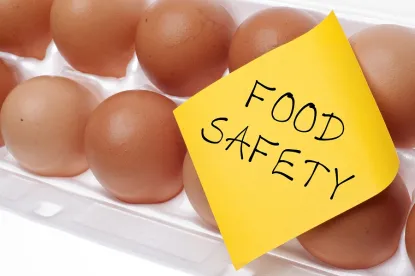The U.S. Department of Agriculture's (USDA) Agricultural Marketing Service (AMS) final rules at 7 C.F.R. Part 66 implements the National Bioengineered Food Disclosure Standard (NBFDS) and establishes a national mandatory standard for disclosing the presence of bioengineered (BE) food. We have previously discussed the BE labeling requirements here. https://www.khlaw.com/USDA-AMS-National-Bioengineered-BE-Food-Disclosure-Standard-Final-Rule
Consistent with the NBFDS definition, the final rule defines a BE food to exclude foods where modified genetic material is not detectable. As such, 7 C.F.R. 66.9(a) provides three ways a regulated entity can demonstrate - through maintaining proper records - that a food's genetic material is not detectable:
-
Verify that the food is sourced from a non-BE crop or source;
-
Verify that the food has been subjected to a refinement process validated to make the modified genetic material in the food undetectable; or
-
Provide for testing records appropriate to the specific food that confirm the absence of modified genetic material
The regulations go on to provide broad guidelines for a validated refining process at 7 C.F.R. 66.9(b) and for standards of performance for detectability testing at 7 C.F.R. 66.9(c) but the industry has been waiting for more detailed guidance from the Agency. On July 2, 2020, USDA AMS published two final guidance documents to provide further clarity on how the industry can validate a refining process and demonstrate that genetic material is not detectable to be exempt from BE labeling requirements: (1) Guidance to Ensure Acceptable Validation of a Refining Process and (2) Guidance on Testing Methods. We further discuss both of these guidance documents below.
Validation of a Refining Process
Being able to demonstrate that a food has gone through a validated refining process has several advantages. While there may be the initial cost of validating the process, any food subsequently refined through that process does not need to be tested for the presence of modified genetic material. Additionally, once a process has been validated, that process can be used at multiple facilities or by multiple manufacturers without having to be re-validated. These advantages are contingent upon maintaining records to demonstrate the process has been validated and that the validated process was followed.
AMS has identified eight general steps to validate a refining process:
-
Identify raw materials, ingredients, and product-contact materials
-
Define characteristics and intended uses of end product
-
Define the sequence and interaction of all processing steps used to arrive at the end product
-
Identify key step or steps in the refinement process that may influence the end product's characteristics and its ability to meet specified requirements
-
Assemble relevant validation information that demonstrates the refinement process operates as intended to meet specified requirements (end product characteristics), conducting studies as needed
-
Continually verify the refinement process is operating as validated
-
Re-validate the refinement process, as applicable, if significant changes are made to the process
-
Maintain record(s) of the validation and ongoing verification
Identifying the "key steps" of a refinement process is particularly important. A key step "is any action or activity that can influence (prevent, reduce, or eliminate) the ability to meet specified requirements." The key steps are the steps that render modified genetic material undetectable. When the key steps have been identified they must be defined by measurable parameters (e.g., time, temperature, content level) and decision criteria (i.e. limits). By identifying the key steps, regulated entities can avoid re-validating an entire process if minor changes occur which do not impact the key parameters.
A process is validated by the collection of evidence and data to demonstrate that the key step(s) consistently and effectively meet specified requirements, namely that they render any modified genetic material undetectable. This evidence and data can be collected through a variety of ways depending on the product, the process, and the specified requirements. It is not necessary to generate new data and/or evidence if it is already available from other sources. The key is to properly maintain any and all relevant records. Once a process is validated, the "key step" parameters must be monitored to ensure that the refinement process continually operates as validated. Regulated entities should establish a system to record measurements that verify the key steps are operating as intended. If a significant change is made to any key step, the process will need to be re-validated. Significant changes are "changes to the defined key step(s) that could impact or affect the process's ability to meet specified requirements."
Standards of Performance for Detectability Testing
The BE labeling regulations identify the standards of performance for detectability testing at 7 C.F.R. 66.9(c):
-
Laboratory quality assurance must ensure the validity and reliability of tests results
-
Analytical method selection, validation, and verification must ensure that the testing method used is appropriate (fit for purpose) and that the laboratory can successfully perform the testing
-
The demonstration of testing validity must ensure consistent accurate analytical performance
-
Method performance specifications must ensure analytical tests are sufficiently sensitive for the purposes of the detectability requirements of this part
The recently released AMS guidance addresses five general top areas, including general considerations in selecting test methods, DNA-based methods, emerging technologies and other methods, general considerations in selecting a laboratory, and recordkeeping requirements.
Regulated entities should ensure that a chosen testing method is fit for purpose. AMS guidance identifies the following factors as "critical" for ensuring the method is fit for purpose:
-
Specific to analyte of interest (i.e. define what is being measured such as genomic DNA or a specific GM event or set of events)
-
Appropriate (validated) for the product/commodity being tested
-
Accurate, precise, robust, reliable, and reproducible
-
Applicable range for the measurement value (i.e., appropriate sensitivity)
-
Accessible and practical for testing needs
Regulated entities should use validated methods for testing accepted by international bodies, such as ISO, Codex Alimentarius Commission, and AOAC International. Additionally, entities can validate their own methods to detect modified genetic material, but should take care to consider sensitivity, specificity, accuracy, robustness, probability of detection (POD), limit of detection (LOD), limit of quantification (LOQ), applicability, selectivity, species specificity, repeatability, and reproducibility. The Guidance also points to internationally-accepted standards-producing bodies that have established criteria that provide a basis for developing an analytical scheme to determine the presence and nature of recombinant DNA in a food or food ingredient.
PCR is the most widely used method to test for detectable modified genetic material. This includes both quantitative and qualitative PCR. Broad spectrum PCR testing may be sufficient to detect plant DNA and both known and unknown genetic modifications. However, in some situations event-specific or construct-specific tests may be necessary. Laboratories must ensure that the chosen method is validated for the specific matrix and adequately extracts DNA for each ingredient/matrix, while also monitoring any potential PCR inhibiting compounds. Other genetic tests (e.g., DNA sequencing) may also be acceptable if they meet the requirements of 66.9(c), referenced above.
Finally, the Guidance provides that records must be maintained for at least two years beyond the date the food or food product is sold or distributed for retail sale. Records can be kept in electronic or paper format. Examples of customary or reasonable records include supply chain records, laboratory testing results, and other records generated or maintained by the regulated entity in the normal course of business.





 />i
/>i

